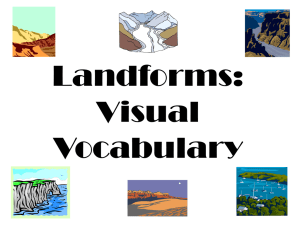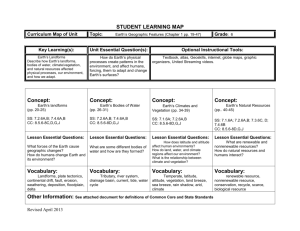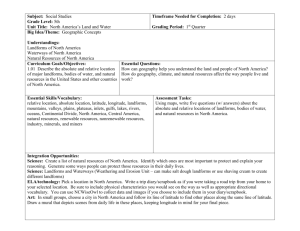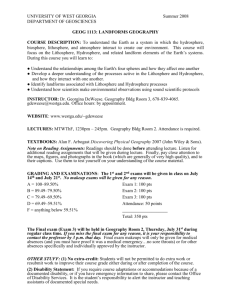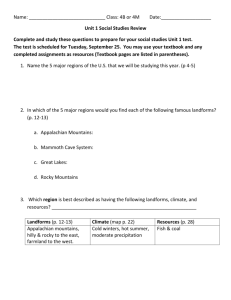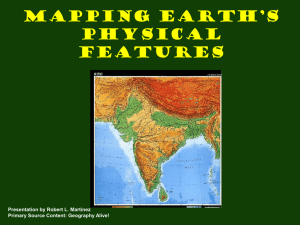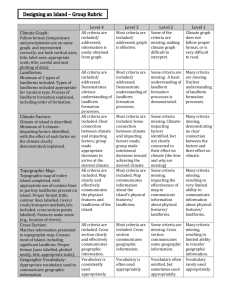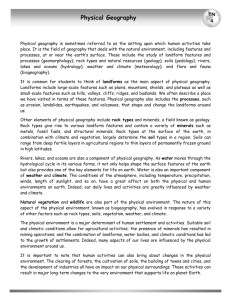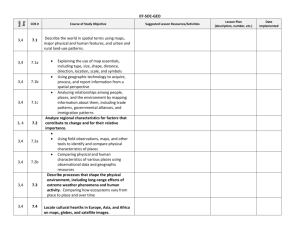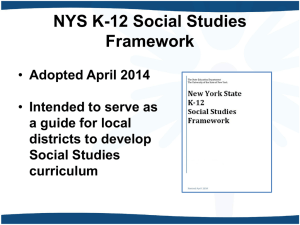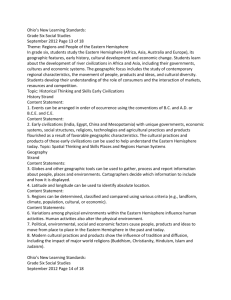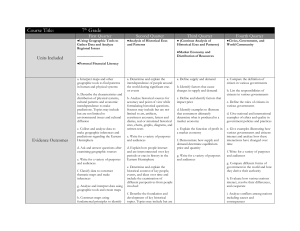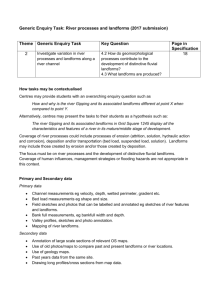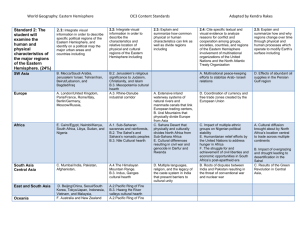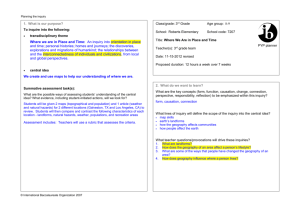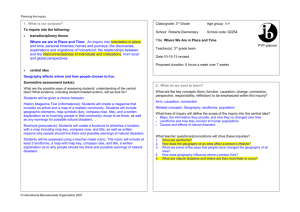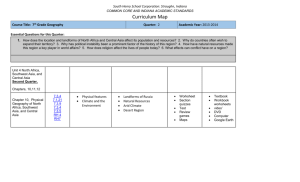7th grade~Geography: Eastern Hemisphere
advertisement
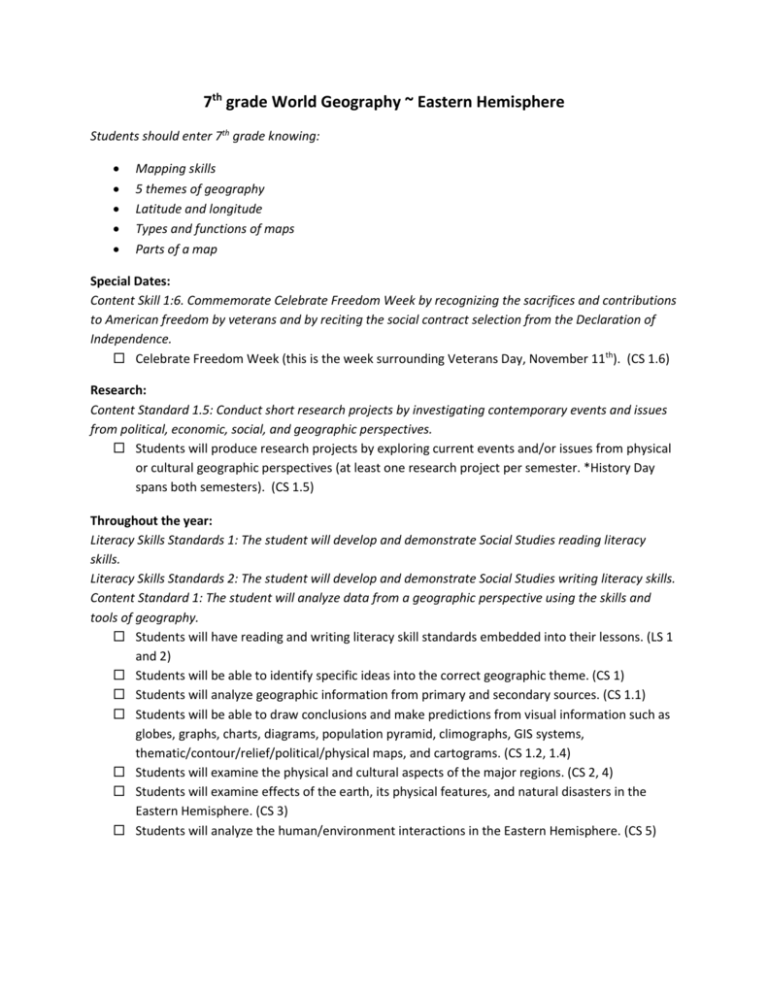
7th grade World Geography ~ Eastern Hemisphere Students should enter 7th grade knowing: Mapping skills 5 themes of geography Latitude and longitude Types and functions of maps Parts of a map Special Dates: Content Skill 1:6. Commemorate Celebrate Freedom Week by recognizing the sacrifices and contributions to American freedom by veterans and by reciting the social contract selection from the Declaration of Independence. Celebrate Freedom Week (this is the week surrounding Veterans Day, November 11th). (CS 1.6) Research: Content Standard 1.5: Conduct short research projects by investigating contemporary events and issues from political, economic, social, and geographic perspectives. Students will produce research projects by exploring current events and/or issues from physical or cultural geographic perspectives (at least one research project per semester. *History Day spans both semesters). (CS 1.5) Throughout the year: Literacy Skills Standards 1: The student will develop and demonstrate Social Studies reading literacy skills. Literacy Skills Standards 2: The student will develop and demonstrate Social Studies writing literacy skills. Content Standard 1: The student will analyze data from a geographic perspective using the skills and tools of geography. Students will have reading and writing literacy skill standards embedded into their lessons. (LS 1 and 2) Students will be able to identify specific ideas into the correct geographic theme. (CS 1) Students will analyze geographic information from primary and secondary sources. (CS 1.1) Students will be able to draw conclusions and make predictions from visual information such as globes, graphs, charts, diagrams, population pyramid, climographs, GIS systems, thematic/contour/relief/political/physical maps, and cartograms. (CS 1.2, 1.4) Students will examine the physical and cultural aspects of the major regions. (CS 2, 4) Students will examine effects of the earth, its physical features, and natural disasters in the Eastern Hemisphere. (CS 3) Students will analyze the human/environment interactions in the Eastern Hemisphere. (CS 5) Checklist: 1st quarter: Review and skill development: o Mapping skills o 5 Themes of Geography Including: Government, Religion, Economics, and Culture Europe o Major Countries and Cities (CS 2.1.A) o Inland waterways and canals (CS 2.3.A) o Physical Features (CS 2.2.A.3, 2.3.B) Landforms (CS 3.1.A) Bodies of Water (CS 3.1.B) o European Union (CS 2.4.D, 4.6.A) o Forms of Economic Systems in Europe (CS 4.4.B) o Forms of Government in Europe (CS 4.5.A) o Culture Labor Markets in Developed Countries (CS 4.7.B) Immigration (CS 4.7.C) o Human/Environment Interaction Resources (CS 5.1.C, 5.1.D) Living Spaces in the Netherlands (CS 5.2.B) nd 2 quarter: Russia and the Eurasian Republics o Major Countries and Cities (CS 2.1.A) o Physical Features Landforms (CS 3.1.A) Bodies of Water (CS 3.1.B) o Government in Russia (CS 4.5.B) o Economic Developments (CS 5.3.B) o Human/Environment Interaction Resources (CS 5.1.C) Regional Issues Aral Sea (CS 5.3.A) Chernobyl (CS 5.2.E) Asia o East Asia Major Countries and Cities (CS 2.1.D) Physical features Ring of Fire (CS 2.2.A.2, 3.2.A) Major Landforms (CS 3.1.A) Major Bodies of Water (CS 3.1.B) Human/Environment Interaction Flooding (CS 3.2.D) Resources (CS 5.1.A) Terraced Farming (CS 5.2.D) Three Gorges Dam (CS 5.3.C) Culture Regions o Huang He River Valleys (CS 2.2.B.3) Economics o China’s reforms (CS 4.4.A, CS 4.7.D) o Japan’s market system (CS 4.4.C, CS 4.6.B) o North Korea’s command economy (CS 4.4.D) 3rd quarter: o Southeast Asia Major Countries and Cities (CS 2.1.D) Major Landforms (CS 3.1.A) Culture Economics o Deforestation (CS 5.2.A) o South Asia Major Countries and Cities (CS 2.1.C) Physical features Himalayan Mountain Range (CS 2.2.A.4) Major Landforms (CS 3.1.A) Major Bodies of Water (CS 3.1.B) Human/Environment Interactions Monsoon patterns (CS 3.2.C) Green Revolution (CS 2.5.C) Culture India (CS 2.3.D) o Caste System o Multiple languages o Multiple religions o Push/Pull factors in migration (CS 4.7.A) o Disputes with other countries (CS 2.4.B) Economics o Outsourcing jobs to developing countries (CS 4.6.C) Middle East (including Southwest Asia) o Major Countries and Cities (CS 2.1.B, CS 2.1.E) o Physical Regions (CS 2.2.A.1) o Physical Features o o Landforms (CS 3.1.A) Bodies of Water (CS 3.1.B) Culture Regions (CS 2.2.B.2) Conflict and Cooperation (CS 2.4.A) Cultural Diffusion (CS 2.5.A) Human/Environment Interaction Resources (CS 5.2.C) Regional Issues (CS 2.5.D, CS 3.2.B) Drought (CS 3.2.B) 4th quarter: Sub-Saharan Africa o Major Countries and Cities (CS 2.1.E) o Physical Features Landforms (CS 3.1.A) Bodies of Water (CS 3.1.B) Deserts (CS 2.3.C, CS 2.5.B) o Culture Regions (CS 2.2.B.1, CS 2.2.B.3) Darfur and Rwanda (CS 2.3.E) Conflict and Cooperation (CS 2.4.E, CS 2.4.F) Nigerian Stability (CS 2.4.C) o Human/Environment Interaction Resources (CS 5.1.B) Regional Issues General Eastern Hemisphere Review o Political Locations (CS 2.1) o Landforms (CS 3.1.A) o Bodies of Water (CS 3.1.B) o Culture (CS 4) Oceania o Major Countries and Cities (CS 2.1.F) Students should leave 7th grade with a mastery of: How to make use of maps Interpreting maps Interpret, analyze, and compare and contrast text, images, etc. Absolute location Understand multiple governments, cultures, and religions and how these affect world make-up *Literacy Standards (LS) and Content Standards (CS) come from the Oklahoma Academic Standards for the Social Studies. **Lesson plans aligned to these standards and checklist are available on the district Google Drive. Contact Heather Goodenough for access. hdgoodenough@baschools.org



